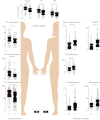The Human Microbiome Project strategy for comprehensive sampling of the human microbiome and why it matters
- PMID: 23165986
- PMCID: PMC3574278
- DOI: 10.1096/fj.12-220806
The Human Microbiome Project strategy for comprehensive sampling of the human microbiome and why it matters
Abstract
The Human Microbiome Project used rigorous good clinical practice standards to complete comprehensive body site sampling in healthy 18- to 40-yr-old adults, creating an unparalleled reference set of microbiome specimens. To ensure that specimens represented minimally perturbed microbiomes, we first screened potential participants using exclusion criteria based on health history, including the presence of systemic diseases (e.g., hypertension, cancer, or immunodeficiency or autoimmune disorders), use of potential immunomodulators, and recent use of antibiotics or probiotics. Subsequent physical examinations excluded individuals based on body mass index (BMI), cutaneous lesions, and oral health. We screened 554 individuals to enroll 300 (149 men and 151 women, mean age 26 yr, mean BMI 24 kg/m, 20.0% racial minority, and 10.7% Hispanic). We obtained specimens from the oral cavity, nares, skin, gastrointestinal tract, and vagina (15 specimens from men and 18 from women). The study evaluated longitudinal changes in an individual's microbiome by sampling 279 participants twice (mean 212 d after the first sampling; range 30-359 d) and 100 individuals 3 times (mean 72 d after the second sampling; range 30-224 d). This sampling strategy yielded 11,174 primary specimens, from which 12,479 DNA samples were submitted to 4 centers for metagenomic sequencing. Our clinical design and well-defined reference cohort has laid a foundation for microbiome research.
Figures


References
Publication types
MeSH terms
Grants and funding
LinkOut - more resources
Full Text Sources
Other Literature Sources
Medical

